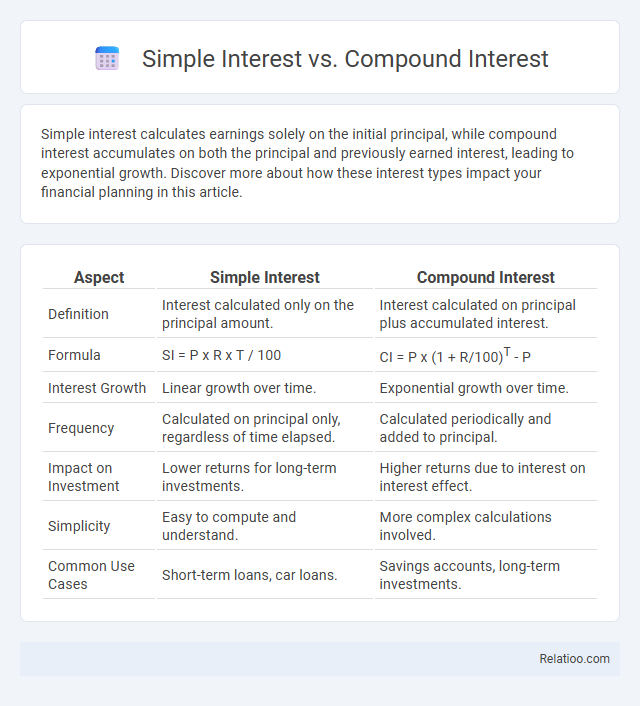Simple interest calculates earnings solely on the initial principal, while compound interest accumulates on both the principal and previously earned interest, leading to exponential growth. Discover more about how these interest types impact your financial planning in this article.
Table of Comparison
| Aspect | Simple Interest | Compound Interest |
|---|---|---|
| Definition | Interest calculated only on the principal amount. | Interest calculated on principal plus accumulated interest. |
| Formula | SI = P x R x T / 100 | CI = P x (1 + R/100)T - P |
| Interest Growth | Linear growth over time. | Exponential growth over time. |
| Frequency | Calculated on principal only, regardless of time elapsed. | Calculated periodically and added to principal. |
| Impact on Investment | Lower returns for long-term investments. | Higher returns due to interest on interest effect. |
| Simplicity | Easy to compute and understand. | More complex calculations involved. |
| Common Use Cases | Short-term loans, car loans. | Savings accounts, long-term investments. |
Introduction to Simple and Compound Interest
Simple interest calculates earnings based solely on the original principal, making it straightforward for short-term loans and investments. Compound interest generates returns on both the initial principal and accumulated interest, accelerating growth over time through compounding periods. Understanding the difference between simple and compound interest is essential for effective financial planning and maximizing investment returns.
Definition of Simple Interest
Simple interest is calculated only on the principal amount of a loan or investment, without compounding over time. It is determined by multiplying the principal, the interest rate, and the time period, resulting in a linear growth of interest. Unlike compound interest, which accumulates on both the principal and previously earned interest, simple interest provides a straightforward and predictable return or cost.
Definition of Compound Interest
Compound interest is the interest calculated on the initial principal, which also includes all accumulated interest from previous periods, leading to exponential growth over time. Unlike simple interest, which is computed solely on the principal amount, compound interest reinvests earned interest, boosting the total return. This method is widely used in savings accounts, loans, and investments to maximize earnings through interest-on-interest effects.
Key Differences Between Simple and Compound Interest
Simple interest is calculated only on the original principal, resulting in a linear growth of the investment or loan amount over time. Compound interest is earned on both the initial principal and the accumulated interest, causing exponential growth due to interest-on-interest effects. The fundamental difference lies in how interest is applied: simple interest yields fixed returns per period, while compound interest accelerates earnings by reinvesting interest, significantly impacting long-term financial outcomes.
Formula for Calculating Simple Interest
Simple interest is calculated using the formula SI = P x R x T / 100, where P represents the principal amount, R is the annual interest rate, and T is the time period in years. Unlike compound interest, which is calculated on the principal plus accumulated interest, simple interest is computed solely on the original principal amount, making it straightforward and easy to determine. Understanding the distinction between simple and compound interest is crucial for evaluating different loan or investment options based on their total interest calculations.
Formula for Calculating Compound Interest
Compound interest is calculated using the formula A = P(1 + r/n)^(nt), where A represents the amount on investment, P is the principal amount, r is the annual interest rate, n is the number of times interest is compounded per year, and t is the time in years. Simple interest uses the formula I = P * r * t, calculating interest only on the principal, whereas compound interest calculates interest on both the principal and accrued interest, resulting in exponential growth. Understanding these formulas is essential for accurately comparing financial products and investments based on their interest calculation method.
Pros and Cons of Simple Interest
Simple Interest calculates interest only on the principal amount, making it straightforward and predictable, which benefits borrowers with clear payment schedules but limits potential growth for investors. Your payments remain consistent over time, avoiding surprises due to accrued interest on interest, which contrasts with Compound Interest that grows faster but can lead to larger debts. The simplicity of Simple Interest allows easier financial planning but may not maximize earnings in long-term investments.
Pros and Cons of Compound Interest
Compound interest accelerates investment growth by earning interest on both principal and accumulated interest, making it highly beneficial for long-term savings and retirement accounts. However, its complexity can be challenging for beginners to understand, and if compounding applies to debt, it may significantly increase the amount owed over time. Compared to simple interest, compound interest leverages exponential growth but requires careful management to avoid unmanageable financial obligations.
Real-Life Examples and Applications
Simple interest calculates interest solely on the original principal, commonly used in short-term loans like car financing or personal loans. Compound interest, which accrues on both the principal and accumulated interest, is prevalent in savings accounts, retirement funds, and mortgages, enabling exponential growth over time. Understanding the difference helps individuals optimize investments and loan costs based on financial goals, such as maximizing returns with compound interest or minimizing interest payments with simple interest loans.
Choosing the Right Interest Type for Your Needs
Simple interest calculates earnings based only on the principal amount, making it ideal for short-term loans or investments where predictability is key. Compound interest grows exponentially by reinvesting earned interest, benefiting long-term savings and investments through accelerated wealth accumulation. Selecting between simple and compound interest depends on your financial goals, investment duration, and risk tolerance to optimize returns effectively.

Infographic: Simple Interest vs Compound Interest
 relatioo.com
relatioo.com